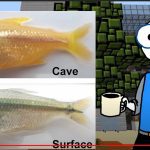[Originally published as Exposing Weaknesses of Darwinism]
The apostle John saw a vision of the end times in which he saw evil spirits that looked like frogs coming from the mouth of the dragon, the mouth of the beast, and the mouth of the false prophet (Rev. 16:13).
Frogs, known for their repetitive croaking, maybe a symbolic picture of a technique that is often used to convince people that something is true even when there is little or no evidence for it. “Millions and millions of years” is one of the repetitive phrases we have all heard that emphasizes the supposed age of the universe, the earth, and ancestral living organisms.
Books, movies, documentaries, and teachers declare with one voice that the earth is billions of years old and that dinosaurs lived on the earth millions of years ago. Young children, who are invariably fascinated by dinosaurs, are routinely told this as a fact. They grow up accepting the idea that dinosaurs lived millions of years ago. Therefore, they reason that the earth must also be millions of years old.
Many people are never exposed to the assumptions or lack of evidence behind the claim.
Children can be persuaded to believe many things about science and history if the same story is repeated often and they are not allowed to hear the legitimate scientific challenges. Fortunately, parents can now find a variety of books and videos that provide alternative accounts to Darwinian evolution that agree with a young earth, creation, and the global flood.
However, the weaknesses and assumptions of Darwinian evolution cannot remain buried forever. They are being exposed in a variety of publications, on the Internet, in legal challenges, and by conservative professional organizations. Even as some national leaders are making plans to teach evolution progressively from K–12, other leaders are seeing the need to change the one-sided method of teaching evolution. The call for more academic freedom is being heard, and heavy-handed treatment of dissident voices is being resisted.
For example, the claim that dinosaurs lived millions of years before modern humans:
Creation scientists tend to believe that although most dinosaurs died during the flood, at least a few probably survived in the ark and beyond for some time. Mythological stories of dragons fit the descriptions of some kinds of dinosaurs and may even be based on stories about real dinosaurs. The real skeletal head of a newly discovered dinosaur, given the name Hogwartsia dracorex, looks much like many mythological dragons.
In the book of Job, God talks to Job about two animals that easily fit the description of dinosaurs and probably symbolized the pride and self-righteousness in Job’s life. A large collection of drawings and statues of dinosaurs can be found at this amazing website: www.GenesisPark.com. This in itself is strong evidence that people who supposedly never saw a dinosaur were able to produce drawings and statues of them.
There are many other examples of new evidence that are challenging Darwinian evolution. One particularly strong piece of evidence is coming from evolutionary paleontologists themselves. A few years ago, a group of scientists found that there was soft tissue in partially fossilized dinosaur bones. The tissue consisted of elastic vessels resembling blood vessels that contained what appeared to be still intact red blood cells. The same kind of soft tissue has been found in several dinosaur bones by different researchers. Soft tissues from dinosaurs could not possibly have remained as elastic tubes for millions of years.
Evolutionary scientists quickly responded with a hypothesis that bacteria had gotten into the spaces and produced the tubes and cells. Creation scientists produced evidence that this could not be true because the tissue did not have characteristics of bacteria.
In the past when Darwinian evolution was even weakly challenged, any kind of explanation would end the debate. If that didn’t work, the challenger would likely be discredited. But, with the Internet and a proliferation of determined groups ready to challenge Darwinian evolution, things may be changing. So, the debate about soft tissues in dinosaur bones continues to cast doubt that these dinosaur bones are 65 million years old.
Phillip Johnson, a retired law professor at Berkley University, has written several books about the weak evidence that supports Darwinian evolution and its naturalistic foundation. One of his books is prophetic in nature. He reminds Christians that the true test of Darwinism will come when Darwin’s followers are forced to defend his theories in public debates on even terms. He notes that the push by national leaders to teach more and more about Darwinism in schools will be the demise of evolution. He predicts that as students learn more about evolution and its naturalistic foundation, weaknesses will be exposed, dooming Darwinism, “however much political power is summoned to its defense.”
Many people do not consider Darwinian evolution to be a problem for Christians, but ideas like “millions of years” and “the evolution of all living things from a common ancestor” strongly challenge the inerrancy of the Bible. Perhaps dinosaurs are not such a great icon of evolution after all.






